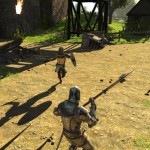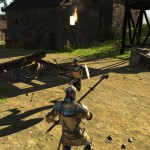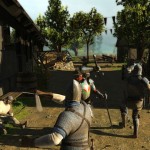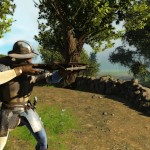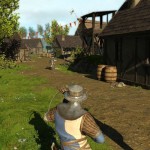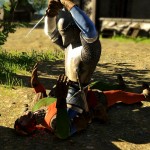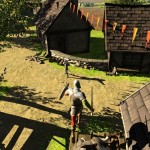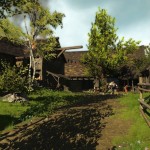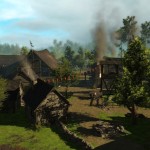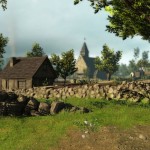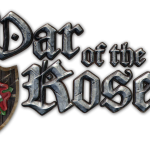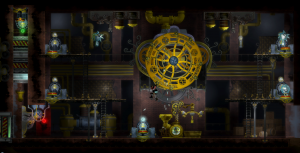War Once Raged Across These Planes
"Smoke rose and blotted the sun, fire lit the smoke from below, and death fueled the fires of war one lost life at a time. Those days of legend and valour are long gone now, centuries of dust have settled on this ancient battlefield, and even the scavengers have left for richer gains. But one small house now stands atop a crest of dirt, a crystalline optic scope jutting from it like a left-over antenna.
He lives there. Some call him infirm for the theories he publishes year after year, his library taken up by the moldering tomes of his science. He has mastered the art of seeing into the past. By day he sits perched on a rickety stool, held together only by twine and purpose, peering into the tiny lens of this great, masterwork temporal looking glass. By night he feverishly writes his findings in records and theses which will eventually lead directly to his demise.
But what of this man's daughter? Neglected and forlorn, she wanders the ancient, barren landscape, carving hidden places and finding curios amidst the aged, unused ruins. She builds with the ancestral fever that encompasses her father, but her pursuit is a much more dramatic one. Sculpting her found art into what must have looked to anyone, were there anyone to see, strange amulets glinting in the heat, rings of great power to keep the past at bay, and full suits of eccentric armour. She was more a historian than her father ever was, and she reforged artifacts of the past in minute detail and scale.
These are her artworks."
Neverwares Website
Monday, September 3, 2012
Wednesday, March 21, 2012
Review - In Deep with Sine Mora
Gameplay: 8
Presentation: 10
Replayability: 7
Overall Score: 9
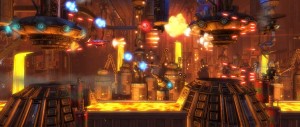 Your ship has three kinds of weapons. Your basic A-button fire, a secondary weapon, and a time-manipulation device. The basic pea-shooter is auto-fire (you can simply hold A to fire, rather than tapping the button repeatedly) and upgradable in 9 steps. The tutorial at the beginning calls these upgrades “permanent” but the power-ups tend to fall out of your ship when you get hit, making them very difficult to hold on to. Imagine you’ve been collecting power-ups for a while and you have just acquired your 7th-step, you come to a particularly hazardous bit of the level and the screen is suddenly filled with projectiles, one of them grazes you and all of your hard-earned power-ups go flying out the nose of your ship. Since this bit is particularly hairy, you dare not sweep across the screen to try and collect them and they all fly off-screen. What you are left with is what amounts to a squirt gun, ineffective and unimpressive. This promotes a feeling of transience in the level of your basic firepower, how very un-permanent. Since the enemies have a true life-meter and take at least a couple hits to take down with the bottom-tier basic weapon, and since killing enemies is how power-ups appear on the screen, it becomes increasingly difficult to acquire power-ups as your machinegun lowers its step.
Your ship has three kinds of weapons. Your basic A-button fire, a secondary weapon, and a time-manipulation device. The basic pea-shooter is auto-fire (you can simply hold A to fire, rather than tapping the button repeatedly) and upgradable in 9 steps. The tutorial at the beginning calls these upgrades “permanent” but the power-ups tend to fall out of your ship when you get hit, making them very difficult to hold on to. Imagine you’ve been collecting power-ups for a while and you have just acquired your 7th-step, you come to a particularly hazardous bit of the level and the screen is suddenly filled with projectiles, one of them grazes you and all of your hard-earned power-ups go flying out the nose of your ship. Since this bit is particularly hairy, you dare not sweep across the screen to try and collect them and they all fly off-screen. What you are left with is what amounts to a squirt gun, ineffective and unimpressive. This promotes a feeling of transience in the level of your basic firepower, how very un-permanent. Since the enemies have a true life-meter and take at least a couple hits to take down with the bottom-tier basic weapon, and since killing enemies is how power-ups appear on the screen, it becomes increasingly difficult to acquire power-ups as your machinegun lowers its step.
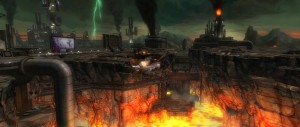 The graphic design is advertised as Diesel-Punk. I don’t know precisely what that means, but it ends up looking like a WW2-era cross between 1942 (the game,) Metropolis, James Cameron’s Avatar (more in the jungle level),Dark Cloud 2, and Last Exile. The game is completely epic in scale and everything big looks, sounds, and feels big. Small things are hard to hit and everything is just impossibly heavy. Deadly, poisonous insects must be navigated around or shot down, huge war Zeppelins fill the sky, floating cities with dubious yet hauntingly beautiful underbellies become the playing field for epic struggles for domination and liberty.
The graphic design is advertised as Diesel-Punk. I don’t know precisely what that means, but it ends up looking like a WW2-era cross between 1942 (the game,) Metropolis, James Cameron’s Avatar (more in the jungle level),Dark Cloud 2, and Last Exile. The game is completely epic in scale and everything big looks, sounds, and feels big. Small things are hard to hit and everything is just impossibly heavy. Deadly, poisonous insects must be navigated around or shot down, huge war Zeppelins fill the sky, floating cities with dubious yet hauntingly beautiful underbellies become the playing field for epic struggles for domination and liberty.
Presentation: 10
Replayability: 7
Overall Score: 9
Sine Mora is a modern 2.5D (2D plane of movement, but rendered in 3D) side-scrolling shoot ‘em up with the heart of a classic. If you are a fan of old-school games like Gradius, R-Type, orDarius, you will certainly feel at home with the fairly simple gameplay mechanics, frantic dodging action, and the huge mega-bosses that permeate the seas and skies of Sine Mora. The game has been co-developed by both Digital Reality (Sky Drift, Dead Block) and Grasshopper Manufacture, (No More Heroes 2: Desperate Struggle, Chainsaw Lollipop) and is being published by Microsoft exclusively for Xbox Live Arcade.
Starting the game, there are several game modes to choose from. You can opt to play Story, Arcade, or Score Attack. Playing Story mode is, predictably, the way you unlock all the characters and ships. That’s where most of the presentation is held with it’s story sequences, prologue chapter, and threaded pilot banter. Story mode also houses the two easiest game settings, Normal and Challenging. Arcade mode ramps up the difficulty with more and tougher enemies, limits your life (here represented as a time limit) to only a few seconds, and also cuts out all of the story bits that you’ve probably seen too many times if you’re willing to jump into this difficulty level. There are two difficulty levels here, Hard and Insane, the latter boasts “FOR THE MANIAKKU OR SUPERPLAY ATTEMPTS ONLY!” It is true, this mode is soul-crushingly hard. Score Attack allows you to play a single level through over and over again, rising in rank on the leaderboards until you are satisfied with your score, then you may move onto any other level you wish to improve upon. This mode also has the Hard and Insane difficulty levels, like Arcade mode.
The action itself is some heart-pounding, side-scrolling stuff. Your ship can take a few hits, but you don’t have a life-meter as much as you do a time-limit. Displayed prominently at the top-centre of the screen, this time-limit can be increased by killing enemies and collecting certain power-ups as you progress and depletes as time wears on into the level. This tends to keep you in the action as you will want to constantly be killing enemies rather than sweeping around them to avoid their fire. There are no breaks in any of the modes other than story, where presentation plays a much bigger role in the game progression.
 Your ship has three kinds of weapons. Your basic A-button fire, a secondary weapon, and a time-manipulation device. The basic pea-shooter is auto-fire (you can simply hold A to fire, rather than tapping the button repeatedly) and upgradable in 9 steps. The tutorial at the beginning calls these upgrades “permanent” but the power-ups tend to fall out of your ship when you get hit, making them very difficult to hold on to. Imagine you’ve been collecting power-ups for a while and you have just acquired your 7th-step, you come to a particularly hazardous bit of the level and the screen is suddenly filled with projectiles, one of them grazes you and all of your hard-earned power-ups go flying out the nose of your ship. Since this bit is particularly hairy, you dare not sweep across the screen to try and collect them and they all fly off-screen. What you are left with is what amounts to a squirt gun, ineffective and unimpressive. This promotes a feeling of transience in the level of your basic firepower, how very un-permanent. Since the enemies have a true life-meter and take at least a couple hits to take down with the bottom-tier basic weapon, and since killing enemies is how power-ups appear on the screen, it becomes increasingly difficult to acquire power-ups as your machinegun lowers its step.
Your ship has three kinds of weapons. Your basic A-button fire, a secondary weapon, and a time-manipulation device. The basic pea-shooter is auto-fire (you can simply hold A to fire, rather than tapping the button repeatedly) and upgradable in 9 steps. The tutorial at the beginning calls these upgrades “permanent” but the power-ups tend to fall out of your ship when you get hit, making them very difficult to hold on to. Imagine you’ve been collecting power-ups for a while and you have just acquired your 7th-step, you come to a particularly hazardous bit of the level and the screen is suddenly filled with projectiles, one of them grazes you and all of your hard-earned power-ups go flying out the nose of your ship. Since this bit is particularly hairy, you dare not sweep across the screen to try and collect them and they all fly off-screen. What you are left with is what amounts to a squirt gun, ineffective and unimpressive. This promotes a feeling of transience in the level of your basic firepower, how very un-permanent. Since the enemies have a true life-meter and take at least a couple hits to take down with the bottom-tier basic weapon, and since killing enemies is how power-ups appear on the screen, it becomes increasingly difficult to acquire power-ups as your machinegun lowers its step.
The secondary fire is dependent on which pilot is flying your ship, each pilot has a different form of secondary fire that they prefer, so there is a little flavour in weapon selection that other similar games are lacking. In Story mode the current pilot is a predetermined value, but in Arcade and Score Attack, you can choose which pilot you’d like to have in the seat. The weapons are anything from basic seeker missiles to splash-damage bombs and some more exotic weaponry. They are generally standard fare, I nearly always choose the seeker missile to help me garner more time when I’m running low.
The time-manipulation devices are one of the main features in this game. When I first heard about this game, I thought that it would be like Braid where you need to puzzle out which things to do at the same time and use a time looping function to achieve that goal. I was disappointed with the final choices the developers made for these devices. They don’t play nearly as much of a role as I thought they would, and, while there is a time-reversal device, none of the devices are utilized as a puzzle mechanic. Indeed, there are no puzzley bits at all in this game. That might be my fault for expecting something different from what, to other people, probably looks like a very standard side-scrolling shooter, but I feel like they missed something that could have made this game stand out, wave their arms, and scream “Look at me! I’m something you’ve never seen before!” At any rate, the manipulation devices range from the aforementioned time-reversal (even after you explode in a firey ball,) to speed-up (which makes everything else look as if it is moving slowly, a huge help for getting out of tight spots,) and even bullet-reflection. Don’t ask me how bullet-reflection is a time-manipulation device, this is not exactly hard sci-fi here. The device that you select before entering a stage is displayed with your other stats on the upper right-hand portion of the screen. Interestingly enough, this gauge appears as a little tube filled with blue, rather than a group of units. This means that you can use your device exactly as much or as sparingly as you choose.
The large multi-part, often multi-screen bosses are impressive and very deadly. Once you’ve played through on Story 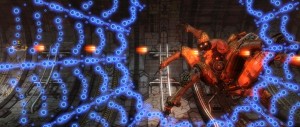 mode and are ready for the Arcade experience, you will fight these bosses over and over again before bringing them down at these higher difficulties. Example: A seemingly impossible-to-avoid lasers that sweeps the screen, depleting your time and killing you instantly can be avoided by flying right up to the optic lens and remaining a constant half centimeter above it as is cleanses the rest of the screen in holy fire. This took me three tries to figure out and another two to actually execute the maneuver in the time between realizing that the enemy is about to shoot and when it actually does. Once I got this technique down, the boss was actually fairly easy. There are numerous patterns for all of the bosses in the game, and as a player you will likewise be trying again and again to figure out that pattern and execute it so that the bosses can be taken down.
mode and are ready for the Arcade experience, you will fight these bosses over and over again before bringing them down at these higher difficulties. Example: A seemingly impossible-to-avoid lasers that sweeps the screen, depleting your time and killing you instantly can be avoided by flying right up to the optic lens and remaining a constant half centimeter above it as is cleanses the rest of the screen in holy fire. This took me three tries to figure out and another two to actually execute the maneuver in the time between realizing that the enemy is about to shoot and when it actually does. Once I got this technique down, the boss was actually fairly easy. There are numerous patterns for all of the bosses in the game, and as a player you will likewise be trying again and again to figure out that pattern and execute it so that the bosses can be taken down.
 mode and are ready for the Arcade experience, you will fight these bosses over and over again before bringing them down at these higher difficulties. Example: A seemingly impossible-to-avoid lasers that sweeps the screen, depleting your time and killing you instantly can be avoided by flying right up to the optic lens and remaining a constant half centimeter above it as is cleanses the rest of the screen in holy fire. This took me three tries to figure out and another two to actually execute the maneuver in the time between realizing that the enemy is about to shoot and when it actually does. Once I got this technique down, the boss was actually fairly easy. There are numerous patterns for all of the bosses in the game, and as a player you will likewise be trying again and again to figure out that pattern and execute it so that the bosses can be taken down.
mode and are ready for the Arcade experience, you will fight these bosses over and over again before bringing them down at these higher difficulties. Example: A seemingly impossible-to-avoid lasers that sweeps the screen, depleting your time and killing you instantly can be avoided by flying right up to the optic lens and remaining a constant half centimeter above it as is cleanses the rest of the screen in holy fire. This took me three tries to figure out and another two to actually execute the maneuver in the time between realizing that the enemy is about to shoot and when it actually does. Once I got this technique down, the boss was actually fairly easy. There are numerous patterns for all of the bosses in the game, and as a player you will likewise be trying again and again to figure out that pattern and execute it so that the bosses can be taken down.
One interesting and very useful function is the addition of a Boss Practice mode, which can be selected at the mode selection screen after you have defeated and unlocked the first boss of the game. This allows you to hone your skills for the boss battles without actually having to go through the entire level to do so. I can think of a few games which would have benefited greatly from this function. (The entire Mega Man series, I’m looking at you.)
One major gripe that I have with this game is that you can’t reconfigure the buttons. Under the “Local Capabilities” heading in the description of the game on XBLA, is states specifically that arcade joysticks are supported. Now, let’s disregard the fact that arcade joysticks are supported in ANY game which uses the D-pad in the same way that it uses the left analog (for movement.) That leaves us with either a convenient button arrangement for use on the arcade stick or input reprogramability to make it work. This game has neither of those things, meaning that when using my HORI arcade stick, the active buttons are spread out over the face button in a very awkward and clunky way. To clarify, what it does have is three control schemes. These schemes may or may not work with whichever arcade stick you currently have, so I will list them here so that you can compare them with your stick layout.
Type A – Primary Fire=A, Secondary Fire=B, Time Capsule=RT
Type B – Primary Fire=A, Secondary Fire=X, Time Capsule=Y
Type C – Primary Fire=A, Secondary Fire=B, Time Capsule=X
The story is told by way of both narrated text at the beginning of each level, and also pilot banter. The opening level narrative is entirely voiced in what sounds like Russian to me, but the text is in English. There is a distinct lack of feeling in each of these sequences. Having the Russian voice-acting seems too melodramatic a move for so flat a delivery, and I find myself skipping over these sequences quite often. On the other hand, the pilot banter sequences are quite good. They are full of character and feeling, you can feel the hatred when one pilot sincerely wishes death on another pilot with whom they are trying to pull off a mission. The character interaction is well written and executed, making for some messed up emotional reactions on the player’s part when you realize, for example, that the pilot you are currently utilizing is blackmailing another into working for him. I ended up rooting for one particular side of that tension, even though I needed to wield all the pilots to their utmost capacity in play.
The timeline in the earlier levels is a little bit convoluted as you play several different points of view that take place simultaneously through the missions. The pilots have strong personalities and are well-characterized, so playing some of them is bonding, and certain stages are memorable, not only for the gameplay and boss battles, but for achieving a goal that the pilots have set for themselves. The dialogue is used as a benchmark as you hear the same clips of conversation before and after communication is broken with some characters and then established with others, introducing new characters and new facets to the increasingly emotionally complicated story of wartime ethics and morality. Unfortunately, during the middle levels, the story is put on the backburner as dialogue doesn’t amount to much more than “I’ll kill you, you giant hunk of metal!” Which leaves us with only he aforementioned flat Russian narratives at the beginnings of each level. In the end, I ended up confused, not because the story was badly written, but because the ethics involved were confusing and I ended up never touching certain pilots in arcade mode because I truly didn’t like their character.
 The graphic design is advertised as Diesel-Punk. I don’t know precisely what that means, but it ends up looking like a WW2-era cross between 1942 (the game,) Metropolis, James Cameron’s Avatar (more in the jungle level),Dark Cloud 2, and Last Exile. The game is completely epic in scale and everything big looks, sounds, and feels big. Small things are hard to hit and everything is just impossibly heavy. Deadly, poisonous insects must be navigated around or shot down, huge war Zeppelins fill the sky, floating cities with dubious yet hauntingly beautiful underbellies become the playing field for epic struggles for domination and liberty.
The graphic design is advertised as Diesel-Punk. I don’t know precisely what that means, but it ends up looking like a WW2-era cross between 1942 (the game,) Metropolis, James Cameron’s Avatar (more in the jungle level),Dark Cloud 2, and Last Exile. The game is completely epic in scale and everything big looks, sounds, and feels big. Small things are hard to hit and everything is just impossibly heavy. Deadly, poisonous insects must be navigated around or shot down, huge war Zeppelins fill the sky, floating cities with dubious yet hauntingly beautiful underbellies become the playing field for epic struggles for domination and liberty.
The characters are Furries. I’m not going to beat around this too much, they are Anthromorphs. The females are designed to look sexy and the males are designed to be hulks. I am not a lover of Anthromorphs utilized in games, but I don’t have a strong aversion to them either. I can forgive the game this slight transgression because the rest of the game is so good. I didn’t mind the cast of StarFox either, since the game was solid and even boundary-pushing for its time, the same holds true here. If you can’t stand Furries in your video games, then I wouldn’t recommend this game to you. If you either don’t mind or love Anthromorphs, these ones are well drawn and characterized. The characters are worthy of the names and personalities they are given.
The music was designed by none other than Akira Yamaoka (Silent Hill, Shadows of the Damned) so be prepared for some eerie delay in the atmospheric noise and piano so soft that it sounds as if the instrument is made of feathers. There are some creepy off-key parts which honestly send chills up my spine in remembrance of older survival horror experiences. A+ music for sure.
If you’re looking for a solid arcade experience, deep characters, and an amazing presentation and find a few extra pesos in your pocket, buy Sine Mora. If you came for Braid-style, genre-shattering, time-manipulation-based puzzle gameplay, take another look at what makes up the core of this game before purchasing, though I still recommend it to everyone with a 360.
** Originally published on levelsave.com **
Saturday, March 17, 2012
Reflections on a Save Crystal Episode 5

In this episode we have more goofs per minute than is federally allowed, they are coated in so much trans fat and poo that we warn against ingesting them all at once. This weeks news was about Diablo III, Mr.Tit, Obsolete PSP games, Birds in space, and Journey.We also tried something new with the audio, let us know what you think.
This episodes reflection is: “We can all agree that music plays an important part in games, but just how important? Can a game be made or broken by its soundtrack? When has music been great, and when has music been terrible for you? During a multiplayer competitive game should there be music? What do you think about the move from actual music to ambient sound? Are there any soundtracks or songs from games that we carry with us from day to day? If so is it because it is good music or is it because it is tied to the memories of the game? Opinions on Custom soundtracks, games they should or should not be in and why?”
First Song was Without Taking the Jewel by Cronamut
Second Song was Walking in Circles by O4ranges
Final Song was Megaman Dubstep Remake
** Originally published on levelsave.com **
Thursday, March 15, 2012
Diablo III Launching May 15 – Digital Pre-Order Open Now
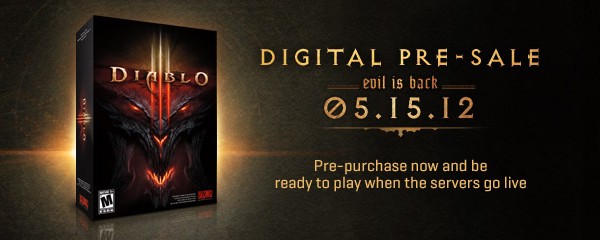
The End of Days approaches…. Diablo III will be unleashed from the Burning Hells on May 15, 2012, and you can be ready to play the minute the servers go live by pre-purchasing the game digitally on Battle.net today.Beginning May 15, players around the world will be able to return to Tristram to discover the dark secrets of a fallen star and begin their quest to save Sanctuary from the impending demonic invasion. To secure your place as a barbarian, monk, demon hunter, witch doctor, or wizard right now, simply log in to your Battle.net account, and then purchase and download* Diablo III, and you’ll be ready to play when the game launches.– Blizzard Entertainment
There you have it, folks. An official release date for the long-anticipated third installment in the venerable Diablo series. This Blizzard classic has captured the imagination of millions of fans across the globe and the latest chapter is shaping up to be just as engrossing.
The free copy with every annual pass to WoW is also still available, but only until May 1. If you are a World of Warcraft fan, and have been waiting patiently for this, here is your in.
With pre-sales now open, I will be securing a copy immediately. Meet you in Tristram!
Labels:
3,
action,
blizzard,
diablo,
iii,
levelsave.com,
Raven Poplar,
rpg
Monday, March 12, 2012
Warlock: Master of the Arcane coming to PC
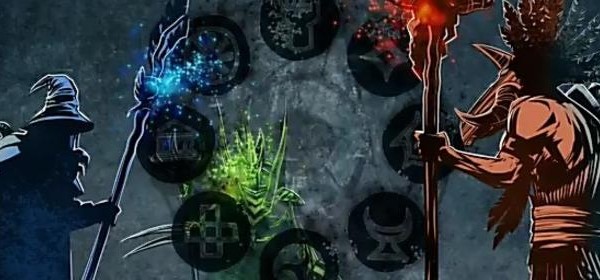
The land is a place of magic and mystery. Mages are powerful and benevolent beings who are looked to, not only for direction and wisdom, but also to rule over the lands they survey. One by one, the Mages came to realise that there is only one solution to the world’s perpetual and perennial problems, one Warlock to rule them all. The bond was struck and the test of might began between all the most powerful wizards in the world, who would become the Warlock?
Nothing less than complete control over the entire world is your ultimate goal in Paradox Interactive’s new upcoming title, Warlock: Master of the Arcane. To be released in the second quarter of this year, this hex-based strategy game looks, on the surface, to be a Civ-like game in a fantasy setting. Judge for yourself with the new trailer unveiled during the recent Game Developers Conference.
Saturday, March 10, 2012
A Wild Trainer Appeared Episode 1
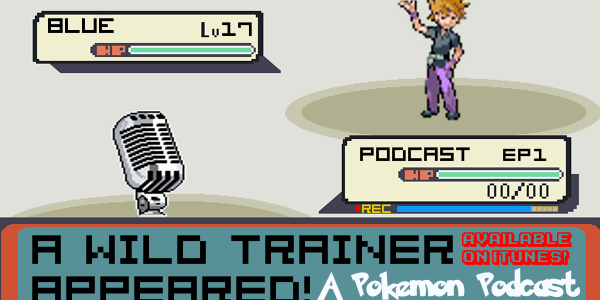
In this episode Raven and Chris talk about how they have not played Pokemon so very much recently. They talk a little speculation about Black and White 2. They also dive deep into Torterra and make one killer moveset.
If you want to join in the conversation send an email to AWildTrainerAppeared@gmail.com
Intro was Pok by Thepipandgrimble
Closing song was Temporal Tower Remix by TheGuitahHero
** Originally published on levelsave.com **
Friday, March 9, 2012
War of the Roses – Death Before Dishonor Video Series Debut
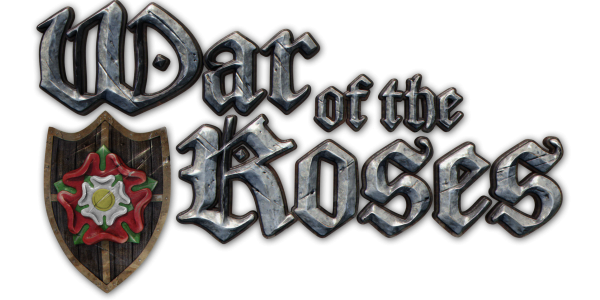
War of the Roses, a multiplayer action game published by leading strategists Paradox Interactive, is currently under development and slated to be released in the third quarter of this year. On the surface the game seems to be somewhat similar to Mount & Blade, though with notable exceptions: Your control of a knight, rather than a commander, being the first and formost difference between the two games; the greater focus on multiplay being a close runner-up. In fact, reports have it that the two games will be played very differently.
A series of videos will be released by Paradox in order to promote the game. The videos, entitled the Death and Dishonor series, have recently received its debut installment, episode 1. This video is somewhat gruesome and may not be for the easily startled, you have been warned.
Also, here are some screencaps.
** Originally published on levelsave.com **
Wednesday, March 7, 2012
New Wakfu Character Class Videos

Showing off the barbarian Sacrier’s Blood and the clockwork Xelor’s Sandglass character classes, these videos give us a peek at the powers and feel of each of these options. Beautifully rendered, multiplayer Tactical RPG Wakfu by Square-Enix offers up much in the way of choice and strategic action, and the character art is so cute.. Kawaai! ^._.^
Wakfu on the web: http://www.wakfu.com/na/mmorpg
** Originally published on levelsave.com **
Labels:
enix,
gaming,
levelsave.com,
multiplayer,
online,
PC,
Raven Poplar,
rpg,
sacrier,
square,
strategy,
video games,
wakfu,
xelor
Defenders of Ardania Coming to XBLA and Windows PC on March 14
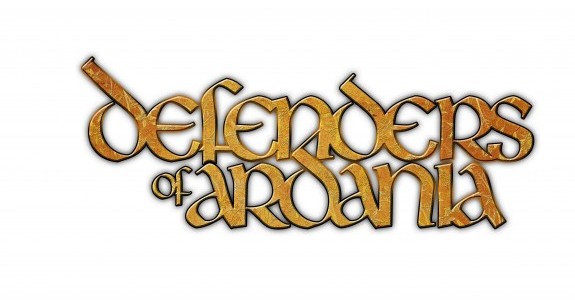
The critically-acclaimed iPad sensation, Defenders of Ardania, has been out on the iPad for a while now and is garnering the attention of strategy gamers everywhere. It was instantly recognized as a quality Tower Defence game with a twist, you control only one faction on a field full of other towers. You send your troops across the perilous paths of traps laid by your enemies and set down damage-dealing towers of your own as one of several unique factions making up the denizens of the Majesty universe.
This recent hit now has a date connected to the release of its XBLA and Windows PC iterations, March 14! The wait is almost over and to celebrate, Paradox Interactive has graced us with a new gameplay video. Let’s take a look:
** Originally published on levelsave.com **
Sunday, March 4, 2012
Review - Vessel: A Steam-Powered, Dystopian Romp
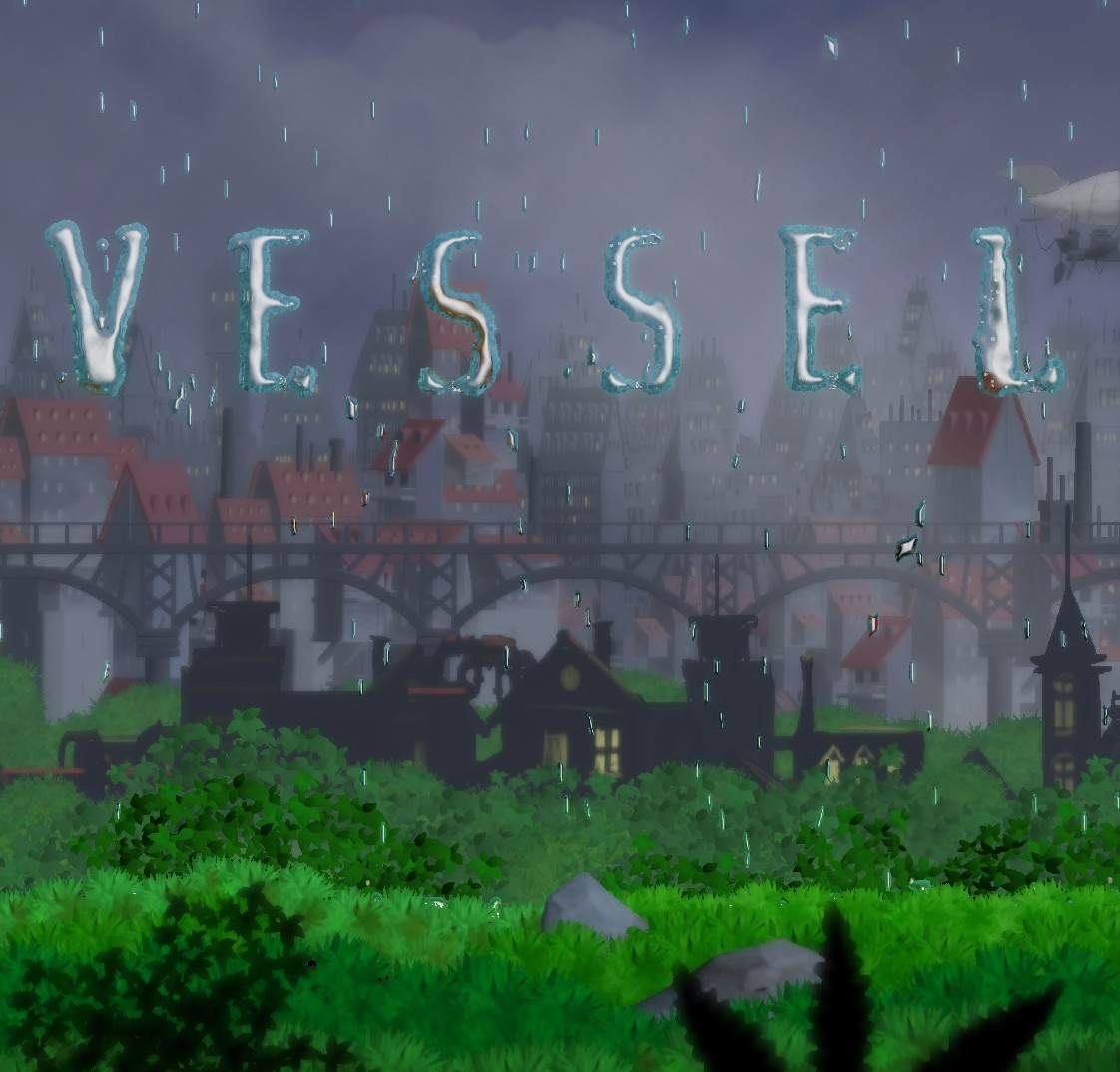
8Overall Score
Presentation:9/10
Gameplay:8/10
Replay Value:6/10
Do Fluros dream of liquid sheep? That is the unanswerable question posed in Strange Loop Games’ new title, Vessel. Combining a run-n-gun/puzzle-platformer game style with an engine built to model particle liquid effects, this game has you working out how to activate the various buttons and levers required to fix each or the 8 broken machines in this Bioshock-esque universe.
You begin the game with a cutscene, stills and text pieced together in true indie game-fashion. The opening movie tells the story of a well-meaning scientist who creates a race of unintelligent creatures known only as the Fluros. These passive creatures would do humanity’s dirty work: The hard and dangerous jobs. After a few years of idyllic, virtually free labour, people began to notice something. Changes in the way the entirely liquid-based Fluros act began to become apparent. New forms of Fluros began being sighted in the bowels of the machinery. Some were not as friendly as their engineered counterparts, and problems began to arise. The factory was shut down and our hero, the aforementioned scientist, is called in to discover the problem with the Fluros and fix the issues so that life can go on once again as normal.
The way this game is feels, with it’s rooms and caverns filled with secret passageways and inaccessible rooms, is often reminiscent of Braid or Myst, as if a deeper meaning could be found in the basic gameplay and images left behind your eyes well after you lay down for bed. The lighting is eerie in certain parts, leading you to believe that there must be some mechanical value to the sparse, lonely lamp hanging from the overhead trolley that you are trundling along on. Unfortunately, Strange Loop missed the boat on that particular mechanic and chose instead to focus more heavily on liquid-physics and lever-pulling. The liquid itself is peculiar, looking more like balls rolling around on the screen than real liquid. I would be hesitant to call this a liquid-physics based puzzle-platformer if the designers didn’t coin it so. It looks more like sophisticated but coarse (as opposed to fine) particle-physics. The environments themselves are in a style that speaks to steampunk, industry, and dungeon-delving. The protagonist seems cut straight from Thomas Dolby’s mythical dystopia, while the abandoned factories seem to scream the word “alone” in the space between our hero’s footsteps, and the caverns drip with water from the damp ceilings. The machines are another matter altogether. These hulking pieces of metal are very functional pieces used almost exclusively to propagate and enhance the gameplay. The steam collectors, iron platforms, and water spouts never seem to quite fit into the look of the environments, as if the rooms were made first and the puzzles built to fit the room, rather than the other way around. This particular phenomenon left me with a feeling that I felt while playing The Incredible Machine. I felt that I should be able to add and remove pieces of machinery at will, which of course would break every puzzle in the game.
The sound is really something else. Your overlarge boots loudly ring out in steel corridors and thud against wet dirt, your begoggled helmet bangs against the ceiling as you try to avoid ground-level lava in a low passageway, and the music.. Strange Loop really scored when they got Jon Hopkins (who worked on the sci-fi hit Monsters and with artists such as Coldplay, Brian Ino, and Imogen Heap.) He has created an original, haunting, full-length electronic album which is dynamically remixed into each puzzle and scene. Returning to themes from earlier levels and providing audio clues as to how to solve each problem that you encounter. If only life had such a soundtrack. The soundscape in this game is nearly perfect.
The main mechanics used in solving these puzzles are smart utilization of the Fluros, your extra hands, your super-soaker backpack/nozzle combo, and the Fluros seeds that you pick up along the way. Each Fluros (Fluro?) is made out of two pieces: 1) The liquid which makes up it’s bulk, and 2) the seed which directs it’s mass to do useful things. Liquid can be found nearly everywhere in this game, I never really found myself running out of water and the canister in my backpack was almost always full. The Fluros take on the properties of the liquid that they’re made out of. Water Fluros are your mainstay cheap labour, lava Fluros act in the same way as their watery brethren, but are much too hot to touch. If water and lava come together, they create great geysers of steam that can be used to power certain
machines. Some Fluros were not engineered by man and act in some strange ways. Predator Fluros will actively attempt to kill you, while one made out of globular fruit-flesh will attempt to assimilate more and more liquid until it reaches a critical capacity and dramatically explodes. Utilization of these various properties are one key to solving the various puzzles you come across. Another tool is your backpack. Made out of a canister and a nozzle, it looks very much like a self-contained fire-fighting tool, or a very primitive proton pack. This backpack has the ability, not only to shoot water, which is expected, but also to reverse the flow and suck up various kinds of liquids which can then be spat back out. This comes in handy from many different puzzles (shooting water down a drain so that it mixes with the lava below, creating enough steam to activate the collector above the chamber, for instance) but is also used as an offensive weapon against the lava Fluros when they are closing on you. A second or two of exposure to water will cool seeded lava enough to destabilize it’s body, crumbling it into a sad little pile with a doomed seed floating around in it. The seeds, yes! These products of high biological tampering are what are used to conform the water around them into a useful form. The friendly spheres with tentacles and legs are fairly fragile but used in almost every puzzle in the game, so you will learn that having an infinite supply of seeds is not only handy, but necessary. The seeds literally attract water in what was coined a “molecular attraction” by the developers. Not only does this make it easier to form Fluros, but you can also manipulate liquid even through walls. This mechanic is utilized sparingly but effectively in many different parts of the game, adding an unexpected element to a fairly simple puzzler.
The puzzles themselves are simple enough that you can retain their entirety in your working memory for days, even if you can’t make it back to the PC. I never lost any sleep going over them in my head, but I can say that coming back to a challenging screen that I’ve been thinking about and solving it nearly immediately is a very rewarding experience. The puzzles don’t ever get too hard, either. There wasn’t ever a point in the game where I scratched me head and saw no way to solve it. There was always some niggling clue (“if only I could figure out why this button is here” or “why does this door open?”) that kept me from giving up.
The replay of this game is hampered by the fact that once you know how to solve the puzzles, there is no challenge anymore, and therefor no satisfaction is gained in replaying the game. With 10-12 hours of gameplay, I would say that this game is priced perfectly at $14.99 on Steam and Strange Loop Games’ own website. I recommend this game to anyone who likedBraid for it’s gameplay elements or is looking for a concise, quirky puzzle experience.
There are plans for Vessel to be released on XBLA and PSN, though no timeline has been released for those iterations.
Buy the game for $14.99 on Steam, or a DRM-free version at Strange Loop Games.
** Originally published on levelsave.com **
Labels:
360,
fluros,
jon hopkins,
levelsave.com,
PC,
platformer,
playstation,
psn,
puzzle,
Raven Poplar,
review,
steam,
steampunk,
strange loop games,
thomas dolby,
vessel,
xbla,
xbox
Subscribe to:
Comments (Atom)
